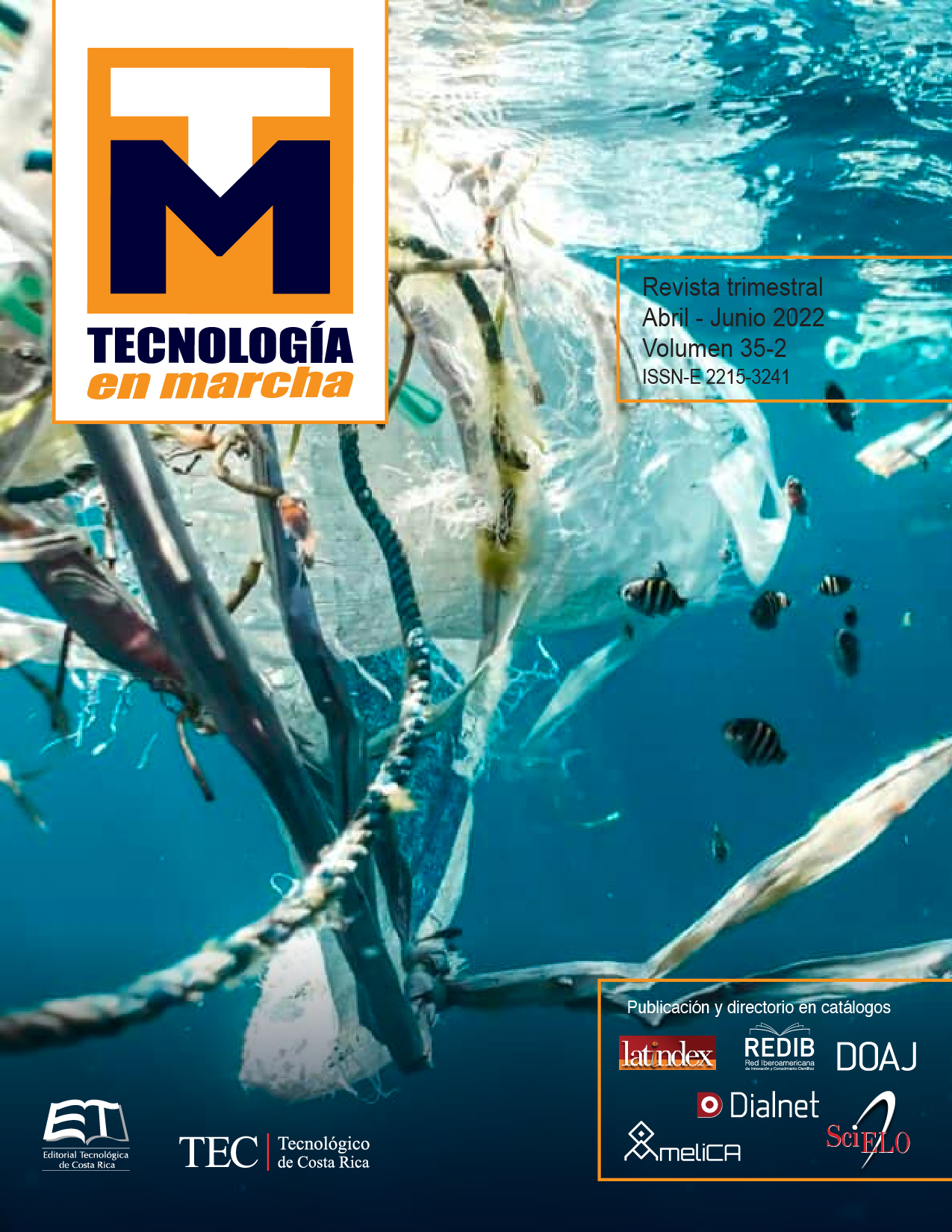Natural organic matter removal by conventional water treatment in a tropical river
Main Article Content
Abstract
In Costa Rica, the effectiveness of the water purification process by conventional method is evaluated primarily in terms of color and turbidity removal and not of natural organic matter (NOM), which, when chlorinated, can form potentially carcinogenic disinfection by-products (DBPs) such as trihalomethanes (THMs). Water from the Jorco river treatment plant, in San José, was monitored, monthly, from March 2015 to February 2016, at each stage of the treatment. Total (TOC) and dissolved (DOC) organic carbon, ultraviolet absorption at 254 nm (UV254) and the specific UV absorbance (SUVA) were quantified. During the hole period, TOC and DOC from crude water ranged between 0,42 ± 0,01 mg-C/L to 0,96 ± 0,19 mg-C/L. UV254 absorbance and SUVA ranged from 0,0106 cm-1 and 2,71±0,55 L/mg-m (dry season) to 0,250 cm-1 and 2,06±1,16 L/mg-m (rainy season), indicating a mixture of aromatic and aliphatic substances in water. In the treatment system, the coagulation-settling stage had the greatest removal efficiency with close to 21% and 23% for TOC and DOC, respectively, during both seasons. The total purification system removed 51% of UV254 and 32% of SUVA, showing the removal of aromatic NOM, a precursor of DBPs. UV254 quantification showed a good correlation with NOM (>99% in accordance with Pearson´s correlation coefficient), indicating its possible use as a substitute for TOC and DOC analysis. Considering the type and low concentration of NOM in raw water together with the efficiency of the treatment, THMs monitoring in the distribution system, confirmed a total trihalomethane (TTHMs) production close to 10 µg/L, well below the national regulations (460 µg L-1 as total trihalomethanes).
Article Details

This work is licensed under a Creative Commons Attribution-NonCommercial-NoDerivatives 4.0 International License.
Los autores conservan los derechos de autor y ceden a la revista el derecho de la primera publicación y pueda editarlo, reproducirlo, distribuirlo, exhibirlo y comunicarlo en el país y en el extranjero mediante medios impresos y electrónicos. Asimismo, asumen el compromiso sobre cualquier litigio o reclamación relacionada con derechos de propiedad intelectual, exonerando de responsabilidad a la Editorial Tecnológica de Costa Rica. Además, se establece que los autores pueden realizar otros acuerdos contractuales independientes y adicionales para la distribución no exclusiva de la versión del artículo publicado en esta revista (p. ej., incluirlo en un repositorio institucional o publicarlo en un libro) siempre que indiquen claramente que el trabajo se publicó por primera vez en esta revista.
References
S. Tak and B.P. Vellanki “Natural organic matter as precursor to disinfection byproducts and its removal using conventional and advanced processes: state of the art review”, J. of Water and Health, vol. 16, no. 5, pp. 681-703, Oct., 2018. doi: 10.2166/wh.2018.032
J. Arboleda, Teoría y práctica de la purificación del agua. Bogotá: (R. Pertuz Ed.) 3era ed., McGraw Hill, 2000.
M. Popov, M. Kragulj, J. Molnar, A. Tubić, M. Watson, M. Šćiban, J. Agbaba, “Fate of natural organic matter and oxidation/ disinfection by-products formation at a full-scale drinking water treatment plant”, Env. Technol., Feb., 2020. https://doi.org/10.1080/09593330.2020.1732474
A. Matilainen, M. Vepsäläinen, M. Sillanpää, “Natural organic matter removal by coagulation during drinking water treatment: A review”, Adv. in Colloid and Interface Sci. vol. 159, pp. 189-197, Jun., 2010. doi:10.1016/j.cis.2010.06.007
I. García “Removal of natural organic matter by enhanced coagulation in Nicaragua”, Licentiate thesis, Chem. Eng. and Technol. Dept., Royal Inst. of Technol., Stockholm, Sweden, 2005.
J. Qin, M. Oo, K. Kekre, F. Knops, P. Miller, “Impact of coagulation pH on enhanced removal of natural organic matter in treatment of reservoir water”, Sep. and Purif. Technol. Vol. 49, pp. 295-298, Sept. 2006. doi:10.1016/j.seppur.2005.09.016
M. Sururi, S. Notodarmojo, D. Roosmini, P. Putra, Y. Maulana, M. Dirgawati, “An Investigation of a Conventional Water Treatment Plant in Reducing Dissolved Organic Matter and Trihalomethane Formation Potential from a Tropical River Water Source”, J. Eng. Technol. Sci. vol. 52, no. 2, pp. 271-288, Apr. 2020. DOI: 10.5614/j.eng.technol.sci.2020.52.2.10
D. Mora-Alvarado, C. Portuguez-Barquero, “Agua para consumo humano y saneamiento en Costa Rica al 2016. Metas al 2022 y al 2030”, Tecnol. en Marcha. vol. 31-2, pp. 72-86, Apr-Jun., 2018. DOI: 10.18845/tm.v31i2.3625
A. Lazo, Comunicación personal, UEN Investigación y Desarrollo, Inst. Costarricense de Acueductos y Alcantarillados, 02 Nov. 2020.
UEN Investigación y Desarrollo, Inst. Costarricense de Acueductos y Alcantarillados, Informe del proyecto: Aplicación de modelos de simulación y análisis geoespacial-ambiental para el estudio de tendencias en la cobertura y uso de la tierra y la dinámica del ecosistema en treinta y dos (32) cuencas hidrográficas de Costa Rica; Cuenca Río Jorco 18 Oct. 2018, pp.51-52
Instituto Meteorológico Nacional (2008). Clima, variabilidad y cambio climático en Costa Rica [Online]. Available: http://cglobal.imn.ac.cr/documentos/publicaciones/CambioClimatico/climaVariabilidadCambioClimaticoCR.pdf
APHA, AWWA, WPCF, Standard methods for the examination of water and wastewater. 21a ed., Am. Public Health Assoc., WA, EUA, 2005.
D.A. Reckhow, and P.C. Singer “Formation and control of disinfection by-products” in: Water quality & treatment. A handbook on drinking water, 6th ed., Denver, CO: Edzwald (ed), 2011, pp. 19.1-19.59.
M.S. “Reforma y adición al Decreto Ejecutivo no. 38924-s del 12 de enero del 2015” Reglamento para la Calidad del Agua Potable. Alcance No. 15 a la Gaceta No. 15 del 22-01-2019. pp 2-16
C. Chow, R. Fabris, M. Drikas, M. Holmes, “A case study of treatment performance and organic character”, J. of Water Supply: Research and Technol. vol 54, no. 6, pp. 385-395, Jul., 2005.
H. Kim and M. Yu, “Characterization of natural organic matter in conventional water treatment processed for selection of treatment processed focused on DBPs control”, Wat. Res. vol. 39, pp. 4779-4789, Sept., 2005.
S. Marais, E. Ncube, T. Msagati, B. Mamba, T. Nkambule, “Comparison of natural organic matter removal by ultrafiltration, granular activated carbon filtration and full scale conventional water treatment”, J. of Env. Chem. Eng. vol. 6, pp. 6282-6289, Oct., 2018. https://doi.org/10.1016/j.jece.2018.10.002
M. Sillampää, M. Ncibi, A. Matilainen, M. Vespäläinen, “Removal of natural organic matter in drinking water treatment by coagulation: A comprehensive review”, Chemosphere, vol. 190, pp. 54-71, Sept., 2018. https://doi.org/10.1016/j.chemosphere.2017.09.113

